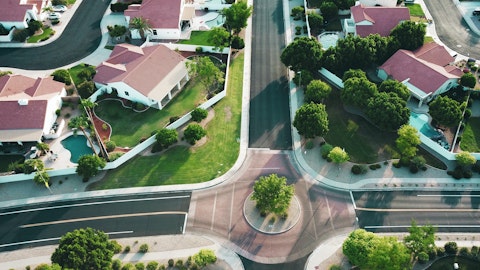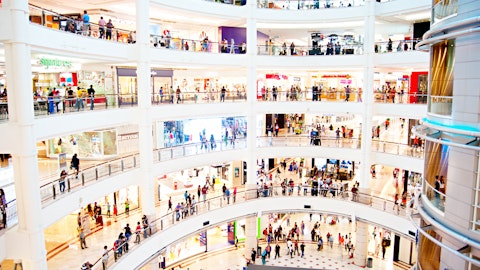Stephen Yalof : Yes, we are, like most of our peer group, we’re out in the marketplace looking for opportunities for our platform to expand. We consider ourselves an open-air shopping center company that has great discipline in leasing, marketing, and operating shopping centers. I think the operating piece is really important because we are asset managers, and if we can find a shopping center that the going-in rate meets our hurdles, and we think there’s upside in the market for us to grow that property and drive additional revenue and shareholder value, we’re going to take advantage of those opportunities.
Samir Khanal: Okay, and then I guess, Michael, just on the CapEx side, I know the guide went down a little bit here, but do you have sort of a big ramp up in next quarter? Maybe expand on that. What’s driving the fourth quarter assumption, thanks.
Michael Bilerman: Sure, Samir. When we talked at the beginning of the year about our overall CapEx, which this year was going to be a higher than last year, we’ve been building back to our historical levels, and within that CapEx range, there’s two components. The first component is our tenant allowances, which as evidenced by our high renewal rate, we’re not having as much TAs because the tenants are renewing with us at pretty much no CapEx. And the other part of it is the capital that we’re putting into our renovations, and those are a little bit more chunky. And so from a timing perspective, our fourth quarter implies, call it at the midpoint about $20 million, and we’ll see how that timing goes in the fourth quarter, but we reduced the overall amount based on the higher renewal rate and the timing of those projects completing.
Samir Khanal: And sorry, would you expect the CapEx levels next year to go down or at this point sort of stay at similar levels that we’re seeing in 2023?
Michael Bilerman: We expect that this total aggregate CapEx will continue to remain at these sort of levels as we got back to where we were pre-COVID, the big factor going into next year is what do we think our renewal rate is? As Steve talked about, you look at our 2 million square feet of leasing, 95% of it was renewals. If we have a lower renewal rate, then we’ll be able to get higher spreads, but the CapEx will be a little bit higher in our numbers. So when we talk in February, we’ll be sure to outline all of those components.
Operator: Our next question comes from the line of Craig Mailman with Citi.
Craig Mailman: Hey, good morning. Like we, you kind of pointed out the $1.00 out of period to take out the run rate. But you’ve also kind of had better expense recoveries as we think about ‘24 and the run rate and stand to the year next year kind of how should we think about whether there’s seasonality in that recovery ratio as we kind of model and what do you think is a good, I understand you never give guidance. But what do you think is a good kind of annualized average for recoveries given what you guys have done on the leasing side recently.
Michael Bilerman: Sure. Thanks, Craig for the question. As we think about operating expenses and recovery, so I think the biggest point is our recoveries are generally fixed, right. So the recoveries are going to seem relatively flattish probably increasing as we’re renewing our space. But the operating expenses in our business are highly variable. And so the recovery rates going to jump around quarter-to-quarter be higher likely in the first half of the year and lower in the back half of the year. As you saw this quarter, we were in the low 80s, which we’d expect to be probably high 70s low 80s in the fourth quarter because that’s the highest quarter of our operating expenses. The highest level of traffic. There’s the most people coming to our centers.
We got to make sure that everything is clean and secure as that happens. And obviously we’re spending a lot of our marketing dollars driving that sales and traffic during the important holiday season. As we think about as we go into next year on average, we probably have a recovery rate in the 80s and it’s going to fluctuate and we’ll be sure as we provide guidance next year to give a little bit more color on some of that seasonality as we move through the year.
Craig Mailman: That’s helpful. And then now that the spend on Nashville is mostly done, you guys have ample balance sheet liquidity. Should we expect, you guys have talked about kind of splitting up boxes and taking some retail space back to put more SMB and centers? Is there any of that in ‘24? And we should be thinking about any NOI coming offline as that disruption happens, or are these still kind of more out-year plans at this point?
Michael Bilerman: So a lot of those initiatives are really leveraging our peripheral land. So we don’t have to take anything offline to be able to do that. It’s the reverse. It’s actually creating something from nothing. Right? We have land that doesn’t have a basis. And as we underwrite those opportunities, we look at an IRR basis relative to our cost of capital, and we have a number of transactions that are going to go through those peripheral land deal. And we’ll take longer to ultimately happen, because we’re generally building a structure relative to just re-leasing the space. But that opportunity provides us a multiyear opportunity to continue to intensify the centers and bring additional uses and retailers to the centers.
Craig Mailman: Okay. And then just one last one, and this goes back to Steve’s commentary on acquisitions. Kind of where are you guys most focused now? Are you guys kind of going through bank portfolios to try to buy some nonperforming loans again in that way? Are you waiting for just the stress and the equity side? Kind of where are you guys mining for opportunities at this point? And what really is the hurdle rate for you guys to kind of deploy outside of open-air outlets into traditional open-air strips?
Stephen Yalof : Look, Craig, a lot in that question, and I’d love to give you an answer. You probably know that we’re looking at all of the above. It’s just we see an opportunity for us as an organization to go on office. We’ve done a great job of leasing the national assets, a great example of a center that we took out of the ground and delivered 96.5% leased, one or two stores left to go. Retailers want to be in our shopping centers. There has been great feedback from the retailer partners and the retailer community on the job that we do as both an operator and a leasing company. They want to be part of the mix and we think we can add great value. So we’re going to look for retail opportunities for us open-air that give us the opportunity to be the principal shopping center in a geography and give us an opportunity to have upside so that we can go after that tenant mix that we’ve now have expanded through our portfolio.
We’ve expanded the muscle of going after entertainment uses. We’ve expanded the muscle of going after food and beverage. And that’s where we think we can add tremendous value as we find properties that we believe to be accretive. Look, I can’t sort of tell you where it’s going to come from because certainly, we’re looking at all different opportunities right now.
Operator: Our next question comes from the line of Todd Thomas with KeyBanc Capital Markets.
Todd Thomas: Hi, thanks. Good morning. So two questions on Nashville, I guess. First, can you talk about the NOI yield at open and provide some color around the trajectory toward the stabilized yield expectation of 7.5% to 8%? And then also, can you share any early read? I know it’s just been a couple of weeks here since the open, but any early read on the open and sales and whether there’s any piece of the NOI early on that’s tied to sales?
Doug McDonald : Sure, Todd, it’s Doug. Sorry. A, while we’ve maintained the stabilized yield of 7.5% to 8%, we still believe that the first year yields are going to be in the 6s, probably around the mid-6s. There are a few different components. The sales momentum does build over time. We expect variable rent will continue to grow in years two and three. There’s also going to be a heavier OpEx spend in year one. The marketing piece is important. It needs to make sure that people understand that there’s a new center in the market. We want to make sure everyone’s first impression is great when they come to the center. So things like the janitorial, landscaping, security, all those pieces we expect could be a little bit heavier in year one as we start to figure out the best way to operate the center and manage those efficiencies going forward.


